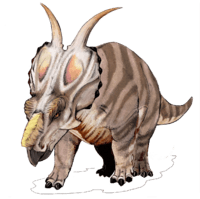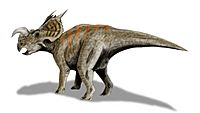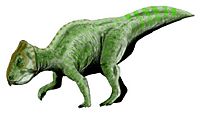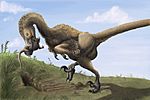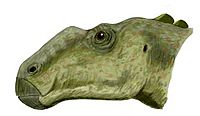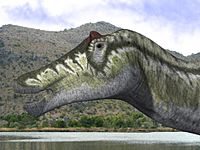Two Medicine Formation facts for kids
Quick facts for kids Two Medicine FormationStratigraphic range: Campanian ~83.5–74.9Ma |
|
|---|---|

Outcrop of the Two Medicine Formation near "Egg Mountain" in northern Montana
|
|
| Type | Geological formation |
| Underlies | Bearpaw Shale |
| Overlies | Virgelle Sandstone |
| Thickness | 600 m (2,000 ft) (western portion) |
| Lithology | |
| Primary | Sandstone |
| Location | |
| Coordinates | 48°04′27″N 112°17′58″W / 48.07417°N 112.29944°W |
| Approximate paleocoordinates | 55°18′N 77°48′W / 55.3°N 77.8°W |
| Region | |
| Country | |
| Type section | |
| Named for | Two Medicine River |
| Named by | Stebinger |
| Year defined | 1914 |
The Two Medicine Formation is a special layer of rock, called a geologic formation. It is found in northwestern Montana in the USA and southern Alberta in Canada. This rock layer formed between 83.5 and 70.6 million years ago. This was during a time called the Campanian stage of the Late Cretaceous period, when dinosaurs roamed the Earth.
This formation is located east of the Rocky Mountains. The western part of the formation is very thick, about 600 metres or 2,000 feet (2,000 feet). It has been folded and faulted by Earth's movements. The eastern part is flatter and thinner. Below the Two Medicine Formation are beach deposits from the Virgelle Sandstone. Above it are ocean deposits from the Bearpaw Shale.
During the Campanian period, the Two Medicine Formation was a land area. It was located between the western shore of a large ancient sea, the Late Cretaceous Interior Seaway, and the growing Cordilleran Overthrust Belt mountains to the west. The formation is mostly made of sandstone, which means it was formed by rivers and deltas.
Contents
Discovering the Two Medicine Formation
In 1913, two teams worked together to find the first dinosaur in this formation. One team was from the United States Geological Survey, led by Eugene Stebinger. The other was from the National Museum of Natural History, led by Charles W. Gilmore.
Stebinger was the first to officially name and describe the Two Medicine Formation. He published his findings in 1914. Gilmore returned to the area in 1928 and 1935. During this time, only three dinosaur species were named. Today, only Styracosaurus ovatus and Edmontonia rugosidens are still considered valid.
Barnum Brown, another famous fossil hunter, explored the formation in 1933. However, he did not find anything important. Both Stebinger's and Gilmore's research was stopped by World War II.
In 1977, a researcher named Trexler found hadrosaur (duck-billed dinosaur) bones near Choteau, Montana. The very next year, baby hadrosaurs were discovered! In 1979, scientists Horner and Makela identified these baby bones as Maiasaura peeblesorum. This discovery made scientists very interested in the formation again. Many new types of dinosaurs were found after that. More nesting sites were later discovered, including the Devil's Coulee site in southern Alberta in 1987. This site yielded Hypacrosaurus stebingeri fossils.
Geology of the Formation
The Two Medicine Formation is made of loose, fine-grained sediments. This allows plants to grow quickly in badland areas. This plant growth can cover up the rock, making it harder to find exposed areas for fossil hunting.
You can often find ancient soils (called Paleosols), river deposits (called fluvial deposits), and layers of a special clay called bentonite in the Two Medicine Formation.
How Old is the Formation?
The Two Medicine Formation dates from about 80 to 74 million years ago. This covers almost the entire Campanian stage. Scientists have used a special dating method called 40Ar/39Ar dating on volcanic ash layers. These ash layers are found about 10 metres (33 ft) (33 feet) below the top of the formation and 105 metres (344 ft) (344 feet) above its base.
The lower part of the Two Medicine Formation is from the late Santonian to early Campanian times. The upper part is from the middle to late Campanian times.
What the Layers Tell Us
The Two Medicine Formation sits on top of the Virgelle Sandstone. The Virgelle Sandstone formed from beach sands when an ancient sea, the Colorado Sea, was shrinking.
Early in the Two Medicine Formation's history, the area was briefly covered by the Interior Seaway. This left behind unusual coastal sediments and isolated shale (mudstone) layers about 100 meters (328 feet) above the base of the formation.
The middle part of the Two Medicine Formation is about 225 meters (738 feet) thick. It formed as the Clagette Sea was shrinking and the Bearpaw Sea was growing. This section is similar in age to the Judith River Formation. The sediments here are mainly bentonitic siltstones and mudstones, with some sandstone lenses. These are thought to be the remains of a coastal plain far from the sea.
The upper part of the formation makes up about half of its total thickness. Its sediments are similar to the middle part but have many red layers and caliche (a type of hardened soil) layers. The very top 80 meters (262 feet) formed after the Bearpaw Sea covered the area. These layers are thought to have been deposited in only 500,000 years. Volcanic ash is common in the Two Medicine Formation.
Ancient Environment
Climate
The Two Medicine Formation was formed in a climate that had seasons. It was semi-dry, with possible rainshadows from the Cordilleran mountains. During the Campanian period, this area had a long dry season and warm temperatures. The types of rocks, invertebrate fossils, and plant and pollen data all support this idea. The many red layers and caliche horizons in the upper Two Medicine show that it was dry at least part of the year. Some dinosaurs found here might have died because of droughts.
Elevation
In the south of the Two Medicine Formation, the land was higher, like an upland environment. Streams flowed northeast from these higher areas. The southern part of the Two Medicine Formation gradually changes into a brackish water (slightly salty) siltstone and sandstone series called the Horsethief Formation. The Horsethief sediments show shallower water deposits than the Bearpaw Shale. This further proves that there were higher elevation areas in the south.
Egg Mountain Site
Egg Mountain is a famous fossil site near Choteau, Montana. It was discovered in 1977 by Marion Brandvold. She found the bones of young dinosaurs there.
Egg Mountain is a place where many dinosaurs nested together. It is famous for its fossil eggs of Maiasaura. This discovery showed for the first time that at least some dinosaurs cared for their young. The eggs were laid in nests dug into the ground. Each nest was about a parent's body length away from the next. Baby dinosaurs were also found with skeletons that were still very soft, like helpless baby birds. This means the parent(s) must have brought food to their young. Plant material found in the nests might be evidence of this, or it could have been used to keep the eggs warm. Maiasaura also grew very fast, as quickly as modern birds. Skeletons of Orodromeus and skeletons and eggs of Troodon were also found at Egg Mountain.
Dinosaur Discoveries
Most rock formations that contain dinosaurs have the same kinds of dinosaurs throughout their layers. Or, the types of species change very slowly. However, some scientists thought the Two Medicine Formation was different, with distinct dinosaur groups at different levels.
Later research showed that the dinosaur groups at different levels were more similar than first thought. The lower and middle sections of the Two Medicine Formation had many types of dinosaurs, but their fossils were not well preserved. This makes it hard to say if these sections had truly different dinosaur groups.
The upper part of the formation has more diverse and better-preserved fossils. Many dinosaurs that were thought to be unique to this upper section have since been found in older layers. For example, Gryposaurus latidens and Hypacrosaurus have been found living at the same time as Maiasaura. Also, fossil teeth suggest that some dinosaur types were present throughout the entire formation.
However, some real changes in dinosaur groups do seem to happen in the upper Two Medicine. The appearance of Maiasaura in the formation happened before many other types of ornithischian dinosaurs arrived. According to David Trexler, careful study of the rocks along the Two Medicine River shows that this increase in dinosaur types was a real event.
The timeline below shows when different dinosaurs lived in the Two Medicine Formation.
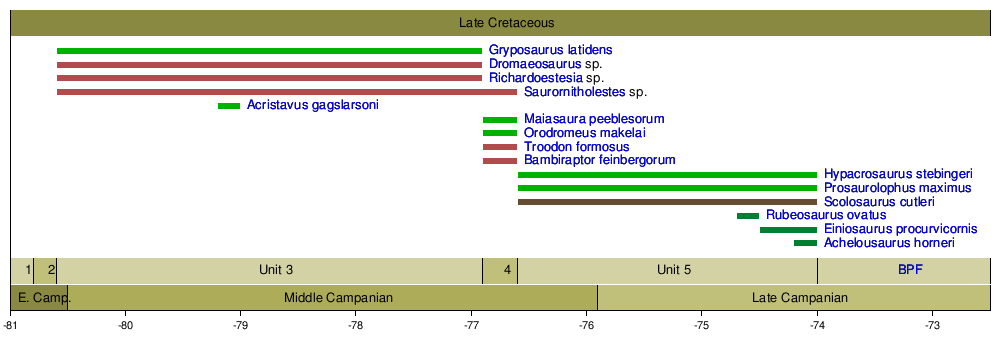
Very few complete dinosaur skeletons have been found in the Two Medicine Formation. Most fossils are isolated bones, bone beds, or poorly preserved pieces. Early studies thought the Two Medicine Formation would have the same dinosaurs as the Judith River Formation. But in 1978, scientists found that the Two Medicine Formation had its own unique dinosaurs. Even some widespread meat-eating dinosaurs had different species here. Dinosaur remains are more common in the upper part of the Two Medicine Formation.
Armored Dinosaurs (Ankylosaurs)
| Ankylosaurs of the Two Medicine Formation | ||||||
|---|---|---|---|---|---|---|
| Genus | Species | Location | Stratigraphic position | Material | Notes | Images |
| Edmontonia | E. rugosidens |
|
Upper | A nodosaurid (a type of armored dinosaur) | ||
| Euoplocephalus | E. tutus | Upper | This was a mistake; these fossils are actually Scolosaurus. | |||
| Not sure |
|
Upper | Also likely Scolosaurus. | |||
| Oohkotokia | O. horneri | Upper | All ankylosaur fossils from this formation were once called Oohkotokia. Later, scientists said Oohkotokia was actually Scolosaurus. | |||
| Scolosaurus | S. cutleri | Upper | An ankylosaurine ankylosaurid. These fossils were first thought to be Euoplocephalus, then Oohkotokia, and now Scolosaurus. | |||
Ancient Birds (Avialans)
| Avialans of the Two Medicine Formation | ||||||
|---|---|---|---|---|---|---|
| Genus | Species | Location | Stratigraphic position | Material | Notes | Images |
| Gettyia | G. gloriae | Upper | "Tarsometatarsus" (a foot bone) | An avisaurid enantiornithean (an early type of bird) | ||
Horned Dinosaurs (Ceratopsians)
| Ceratopsians of the Two Medicine Formation | ||||||
|---|---|---|---|---|---|---|
| Genus | Species | Location | Stratigraphic position | Material | Notes | Images |
| Achelousaurus | A. horneri | Landslide Butte | Upper | "[Three] partial skulls, [one] partial skeleton." | A centrosaurine ceratopsid (a type of horned dinosaur) | |
| Brachyceratops | B. montanensis | Upper | "[Six] partial skulls, skeletons, subadult." | A centrosaurine ceratopsid. It might be a young Rubeosaurus. | ||
| Cerasinops | C. hodgskissi | Lower | A leptoceratopsid (a smaller horned dinosaur) | |||
| Einiosaurus | E. procurvicornis | Landslide Butte | Upper | "[Three] adult skulls, juvenile and subadult cranial and postcranial elements." | A centrosaurine ceratopsid | |
| Prenoceratops | P. pieganensis | Upper | A leptoceratopsid | |||
| Stellasaurus | S. ancellae | Landslide Butte | Upper | "Nasal horn and fragmentary parietal frill." | A centrosaurine ceratopsid | |
| Styracosaurus | S. albertensis | Fragmentary parietal frill. | A centrosaurine ceratopsid | |||
Bird-like Dinosaurs (Non-Avialan Eumaniraptorans)
| Non-avialan eumaniraptorans of the Two Medicine Formation | ||||||
|---|---|---|---|---|---|---|
| Genus | Species | Location | Stratigraphic position | Material | Notes | Images |
| Bambiraptor | B. feinbergorum | Upper | "Almost complete skull and postcrania," type specimen | A saurornitholestine dromaeosaur (a type of raptor) | ||
| Dromaeosaurus | Not sure | Lower | ||||
| Richardoestesia | Not sure | Upper | Teeth | |||
| Saurornitholestes | Not sure |
|
|
Partial skeleton, isolated foot bones | A saurornitholestine dromaeosaur | |
| Troodontidae | Not sure | Upper | Partial skulls, several vertebrae, ribs, etc. | These remains are likely from Stenonychosaurus. Troodon is now a genus that scientists are not sure about. | ||
Duck-billed Dinosaurs (Ornithopods and Parksosaurs)
An unidentified lambeosaurine (a type of duck-billed dinosaur) has been found west of Bynum. It is currently being prepared for a collection.
| Ornithopods and parksosaurs of the Two Medicine Formation | ||||||
|---|---|---|---|---|---|---|
| Genus | Species | Location | Stratigraphic position | Material | Notes | Images |
| Acristavus | A. gagslarsoni | Lower | A saurolophine hadrosaur | |||
| Glishades | G. ericksoni | A hadrosauroid (a group of duck-billed dinosaurs) or a young saurolophine hadrosaur that is hard to identify. | ||||
| Gryposaurus | G. latidens | Two Medicine River |
|
"Several partial skulls and postcranial skeletons." Also isolated teeth. | A saurolophine hadrosaur. The isolated G. latidens teeth are rare in the middle part of the formation. | |
| Not sure | Upper | |||||
| Hypacrosaurus | H. stebingeri |
|
Upper | A lambeosaurine hadrosaur | ||
| Not sure | "Choteau/Bynum" | Upper | ||||
| Maiasaura | M. peeblesorum |
|
Upper | "More than [two hundred] specimens including articulated skull and postcrania, embryo to adult." | A saurolophine hadrosaur. Maiasaura fossils from Choteau are found in higher rock layers than those from the Two Medicine River. It is the most common dinosaur found at the Egg Mountain site. | |
| Orodromeus | O. makelai | "Choteau/Bynum" | Upper | An orodromine parksosaur | ||
| Prosaurolophus | P. maximus |
|
Upper | "Disarticulated, associated skull and postcrania pertaining to at least [four] individuals." | A saurolophine hadrosaur. Prosaurolophus blackfeetensis, named for Two Medicine fossils, is the same as P. maximus. | |
Oviraptorosaurs
The first oviraptorosaur fossil found in Montana was a jaw bone from Caenagnathus sternbergi. This was found in the Two Medicine Formation. This species was previously only known from Alberta, Canada. Scientists have noted that during the late Campanian period, Alberta and Montana had very similar theropod (meat-eating) dinosaurs. This is interesting because the plant-eating dinosaurs in these two areas were quite different.
| Oviraptorosaurs of the Two Medicine Formation | ||||||
|---|---|---|---|---|---|---|
| Genus | Species | Location | Stratigraphic position | Material | Notes | Images |
| Chirostenotes | C. pergracilis | Known from a lower jaw bone, called MOR 1107. | This was previously thought to be Caenagnathus sternbergi (which is now considered the same as Chirostenotes). | |||
Tyrannosauroids
| Tyrannosauroids of the Two Medicine Formation | ||||||
|---|---|---|---|---|---|---|
| Genus | Species | Location | Stratigraphic position | Material | Notes | Images |
| Daspletosaurus | D. horneri | Upper | Bonebed (many bones found together) | |||
| Unnamed species | Upper | Bonebed | More closely related to D. torosus and other species from the Oldman/Dinosaur Park formations than D. horneri. | |||
| Gorgosaurus | G. libratus? | "Choteau/Bynum" | Upper | |||
Color key
|
Notes Uncertain or tentative taxa are in small text; |
Other Ancient Animals
Many other types of fossil animals have been found in the Two Medicine Formation. These include freshwater bivalves (like clams), gastropods (like snails), turtles, and lizards such as Magnuviator. There are also champsosaurs, which were crocodile-like reptiles.
A mammal called Cimexomys (a multituberculate) has been found on Egg Mountain. The species Piksi barbarulna was described from forelimb bones found here. It was first thought to be a bird, but later scientists realized it was a pterosaur (a flying reptile), likely a type of Ornithocheiroidea.
Other azhdarchoid pterosaurs are also known from the Two Medicine Formation. This includes a very large, unnamed azhdarchid with an estimated wingspan of 8 metres (26 ft) (26 feet). A smaller pterosaur, Montanazhdarcho minor, has also been found.
Scientists have also discovered Insect and mammal burrows (tunnels in the ground) and dinosaur coprolites (fossilized poop).
See also
 In Spanish: Formación Two Medicine para niños
In Spanish: Formación Two Medicine para niños






